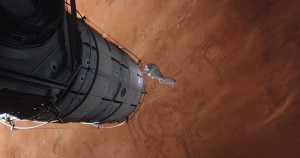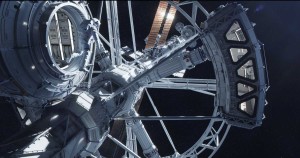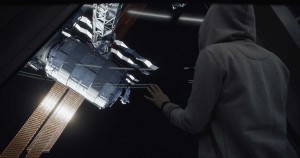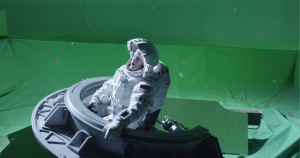
Informed by the heavily researched detail of Andy Weir’s novel, and with significant input from NASA on genuine contemporary technologies, Framestore revelled in the opportunity to further refine the CG and VFX techniques needed to portray a realistic space setting for the year 2035. The dramatic story and its setting are maximized in native stereo, with images of Mars drawn from vast datasets to create a stunning, high-resolution picture.
The build of the Hermes was a major focus for Framestore’s teams. Well over 700 feet in length, the spaceship is the biggest and most complex created by Framestore to date, and is more than double the size of the current International Space Station (ISS). Early pre-visualization and production design defined its measurements, with consideration for practicalities such as the time it would take the astronauts to move around it and the space needed to store supplies for so long a mission. Chris Lawrence, VFX supervisor, noted that this attention to detail was a driving force throughout the project. “Everything we did, we tried to ground in reality,” he said. “It’s sci-fi, but it’s real. The production design isn’t overtly flashy and there is minimal design from scratch.”
 Details for the build were frequently drawn from existing spacecraft designs. Like the ISS, the enormous Hermes has a modular structure since theoretically it would be launched in stages and pieced together in orbit. The six solar array wings (SAWs) are integral to both the look and design of the Hermes, and were a complicated CG challenge for Framestore’s teams. Made of various layers of materials – silicone, plastics and metals – the panels are continuously reflecting and refracting light. “They contain a lot of layers and respond differently depending on distance, light and angle,” said CG supervisor Neil Weatherley. “We had to take a realistic point of view. We’re not used to seeing solar panels in space and they do look strange compared to our Earth view. It was a real challenge to replicate something that looks inherently unnatural to us.”
Details for the build were frequently drawn from existing spacecraft designs. Like the ISS, the enormous Hermes has a modular structure since theoretically it would be launched in stages and pieced together in orbit. The six solar array wings (SAWs) are integral to both the look and design of the Hermes, and were a complicated CG challenge for Framestore’s teams. Made of various layers of materials – silicone, plastics and metals – the panels are continuously reflecting and refracting light. “They contain a lot of layers and respond differently depending on distance, light and angle,” said CG supervisor Neil Weatherley. “We had to take a realistic point of view. We’re not used to seeing solar panels in space and they do look strange compared to our Earth view. It was a real challenge to replicate something that looks inherently unnatural to us.”
The gravity wheel provides the astronauts with a sense of normalcy during their epic mission. Not only does the audience see the astronauts engaged in everyday activities, such as running on a treadmill, but the vast windows allow for spectacular composited views and provide a backdrop for key moments in the story. Large pieces of the wheel were created as physical rotating sets, calling for seamless of integrations between CG and live-action plates.
It was important for the film to maintain a cinematic beauty alongside the dedication to accuracy. Cultural reference points were frequently drawn from 2001: A Space Odyssey, which, Lawrence noted, “Set the subconscious benchmark for what space looks like and how it would feel to be there.” Scott also drew inspiration from Chesley Bonestell’s sci-fi illustrations from the ’50s and ’60s, adding a retro space look into the design mix.
Framestore’s compositors followed suit, delivering a photographic finish to shots of the Hermes. “We used controlled amounts of convolve and glow to beautify the shots,” said Bronwyn Edwards, 2D supervisor. “Nico Coronado Rivero (compositor) developed a lens flare tool, which digitally matched the flares captured in camera, and was used across all of the shots for maximum continuity.”
Designing an entire planet was another challenge for Framestore. With a key opening shot and various space establishers, it was again important to strike the balance between accuracy and cinematic beauty. The studio used the same technology as they did to create the Earth in Gravity, consisting of a volumetric render of extremely high-resolution texture information, combined with dust and atmospheric clouds. The challenge lay in finding adequate reference material for Mars.
 “There’s not much color photography out there,” noted Lawrence. “We used a combination of photography and satellite data, in a fairly novel way, to get everything we needed.”
“There’s not much color photography out there,” noted Lawrence. “We used a combination of photography and satellite data, in a fairly novel way, to get everything we needed.”
Unlike the Earth, with its surface of blues, greens and browns, Mars is a dusty reddish planet. “Our first attempts were realistic, but lacked the interesting variation of color and contrast found on Earth,” said Lawrence. “The movie demanded something more vivid, so we spent time on a creative journey to show the variation in features, surfaces and textures, all of which had to fit with the live-action footage shot in Jordan, plus the scenes at launch stage in the lower atmosphere.”
“We added light clouds to the surface, to echo the dust clouds,” said Weatherley. “Above that, we worked to create something that would add the depth we wanted without importing the fluffy white variety we’re accustomed to on Earth.”
Three key geographical features were used on the planet’s surface: the Olympus Mons, Schiaparelli crater and the Valles Marineris, a 2500-mile Grand Canyon-style feature carved alongside Mars’ equator. Though not all narratively called for, their addition again helped to ground the film’s story in a space reality. “Our hope is that the three landmarks are recognizable to audiences already well-versed in all things space,” said Weatherley.
“The heritage of the book – Weir’s detailed research, the input of real astro-scientists throughout, the refining of the science – just reinforced our desire for authenticity,” added Lawrence. “It was nice to be able to feature real touch-points in this context.”
 The climactic ending of the film incorporates a complex action sequence with a full array of CG assets and effects. “We really have everything in this sequence,” commented Lawrence. “There’s a long spacewalk, an explosion to slow the Hermes, a frenzied, dizzy, spinning Watney, complicated wire rig and CG replacement plus, of course, the Hermes and planet Mars in the background. It was a massive compositing task, and a long sequence, that also needed to look beautiful.”
The climactic ending of the film incorporates a complex action sequence with a full array of CG assets and effects. “We really have everything in this sequence,” commented Lawrence. “There’s a long spacewalk, an explosion to slow the Hermes, a frenzied, dizzy, spinning Watney, complicated wire rig and CG replacement plus, of course, the Hermes and planet Mars in the background. It was a massive compositing task, and a long sequence, that also needed to look beautiful.”
The tethered astronauts proved an extremely technical piece of animation, incorporating a huge amount of cloth simulation on the actual ropework. The astronauts are a combination of live-action footage shot on wire rigs and full CG digi-doubles, composited seamlessly together. Wire removals were an ongoing task for Framestore’s compositors, who worked to create the perfect zero gravity effect.
“The long, slow shots are beautiful to watch, but meant we needed both precise paintwork and tracking as we were working in native stereo,” said Edwards. “Disparity passes from our triage process helped us to map, paint and re-project patches so that the body tracks work in both the left and right eyes. We also had full body stereo roto done as, once we removed the wires, we sometimes found that there was a slight bounce left in their motion that had to be corrected.”
The film was shot in native stereo on RED cameras with 5K plates, resulting in extremely sharp, beautiful imagery. Framestore worked closely with The Third Floor on the technical previs of their shots, particularly while on set for the shoot. “Having Casey Schatz on the ground for technical previs was very useful,” said Lawrence. “We were able to take our detailed model of the Hermes and do real-time interactive post-vis on set with Ridley. It really helped us in composing shots, driving the reality and beauty of what we were doing. It’s difficult for the actors, too, to work mostly on greenscreens and rigs. Previs was so important here as it helped everyone understand what was going on.”
The Martian marks the first use of a triage process for Framestore. Edwards was enlisted to implement the new pipelines for the project, bringing with her valuable experience of native stereoscopic shows. The triage process settles inaccuracies between the left eye and right eye stereo plates, in both color and alignment. Framestore was requested to tackle the work upfront rather than leaving triage until the final stages of compositing, making for a more efficient workflow. “Getting all of that work signed off at an early stage really helped,” commented Edwards. “It saves the rest of the compositing, and the real beauty work, for a later stage without the fear of needing to go back and take it apart.”
The new pipeline was based on The Foundry Ocula toolset. The team, spearheaded by Edwards, spent a great deal of time finessing the technical processes to reach a quality that would stand up to external stereographic standards. The process provided a fine learning opportunity for Framestore’s artists, some of whom had not worked on stereo plates before. “All of our compositors and paint and roto staff worked on at least one triage shot,” said producer Clare Cheetham. “It made their usual compositing work more fluid, requiring them to consider the aesthetic of the shot as well as the technical elements. It was extremely valuable on-the-job training.”
“We had a great relationship with Ridley’s team,” said Cheetham. “Barrie Hemsley, VFX producer, has a strong VFX background so had a detailed understanding of our work and the processes involved. Richard Stammers and Chris [Lawrence] worked closely together too, and were able to share each other’s knowledge. And we were able to use our previous knowledge in this field as a base from which to realize Ridley’s vision for this brilliant original story.”





